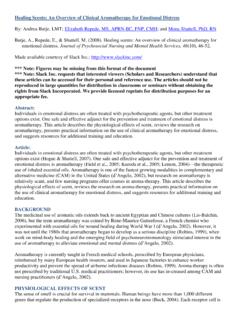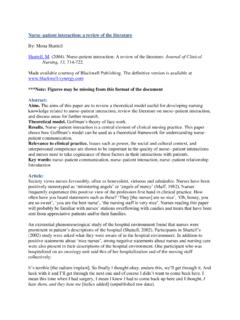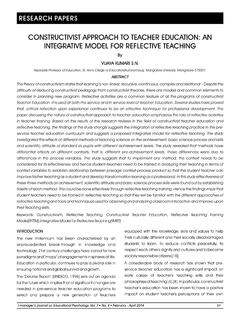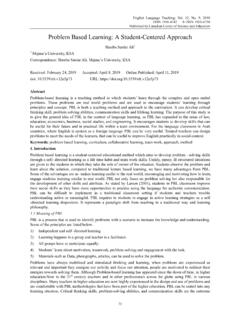Transcription of The Ethic of Care in Teaching: An Overview of Supportive …
1 Made available courtesy of Human Kinetics: **Reprinted with permission. No further reproduction is authorized without written permission from the Human Kinetics. This version of the document is not the version of record. Figures and/or pictures may be missing from this format of the document.**. Quest, 2005, 57, 392-425. 2005 National Association for Kinesiology and Physical education in Higher education The Ethic of Care in Teaching: An Overview of Supportive Literature Lynn M. Owens and Catherine D. Ennis The purpose of this article is to provide an Overview of three theoretical frameworks that appear related to teachers who manifest an Ethic of care. An in-depth review of related literature develops Noddings theory of the Ethic of care, focusing on defining care in teaching. It is further supported with theories of moral develop- ment, the theory of relational knowing, and the role of self in teacher development.
2 This article provides support for considering and incorporating the development of an Ethic of care as fundamental pedagogical content knowledge to be included in pre-service teacher education . The ability to enact an Ethic of care in teaching should be an expectation of effective teachers. Teachers need to able to care for themselves, their students, the content, and other members of the school community. Too often, that ability to care is assumed rather than nurtured or taught. Too often physical education teachers are able to care only for those students who are willing to learn or are athletes. The need exists to better prepare future teachers and assist current teachers in understanding the Ethic of care. Current teacher education programs and professional development programs often fail to address the Ethic of care and its impact on the educational process.
3 While many teachers say they care about students and they care about physical education , without a true understanding of what this really means, teachers may become overwhelmed by the realities of care. Furthermore, if we are to produce caring teachers from our undergraduate physical education teacher education programs, we can not assume that they understand care. Therefore, it is suggested that the Ethic of care become pedagogical content knowledge and part of the under- graduate physical education teacher education curriculum. Given the complexity of the Ethic of care construct, this article should serve to lead the reader to a better understanding of the Ethic of care in physical education . The Ethic of care represents a relatively recent field of study in education . Noddings (1984) groundbreaking philosophical work describing this theory has led other researchers to conduct their own inquiry as they attempt to confirm and expand Noddings theory.
4 Findings have supported and expanded the Ethic of care as an instrumental yet complicated construct in understanding educational settings. This review of literature will provide an Overview of three theoretical frameworks Lynn M. Owens is with the Department of Health and Human Development at Montana State University, Bozeman, MT 59715. E-mail: Catherine D. Ennis is with Department of Kinesiology at the University of Maryland - College Park. E-mail: 392. 03 Owens(392) 392 10/23/05, 12:28:31 PM. Ethic of Care in Teaching 393. that appear related to teachers who manifest an Ethic of care: the Ethic of care, relational knowing, and teacher development of self. Noddings' Theory of the Ethic of Care Noddings (1984) argues that caring should be at the heart of the educational system. This concept serves as the foundation for the theoretical framework of the Ethic of care in education .
5 This innately feminist framework emphasizes the differences between the traditional male dominated view of rules, regulations, and abstract thinking and the more feminine, motherly voice of context that seeks connection and relationship in interactions and decision making. Gilligan s (1982). work on the development of a different voice in girls and Belenky, Clinchy, Goldberger, and Tarule s (1986) notions of women s ways of knowing will be discussed in this section to elaborate Noddings view. Noddings (1992) emphasizes that the concept of school morality should be revised to focus on caring as the moral orientation to teaching. Defining Care Philosophers have offered descriptions of care. Martin Heidegger (1926/1962), a German philosopher, described care as the very Being of life. Milton Mayeroff (1971) notes that to care for other persons is to help them care for themselves.
6 Gordon, Benner, and Noddings (1996, p. xiii) define caring as a set of relational practices that foster mutual recognition and realization, growth, development, protection, empowerment, and human community, culture, and possibility. This definition emphasizes that caring occurs within relationships. The One Caring and the Cared For The basic assumption of Noddings Ethic of care is the reciprocal relation- ship between the one caring and the cared for. In an educational setting, the teacher assumes the role of the one caring while the students are those cared for. In this relationship, the one-caring teacher feels an obligation and a sense of I. must in establishing the caring Ethic . As Noddings (1992) explains, teachers who profess an Ethic of care in their practice view themselves as the ones responsible for empowering their students. The caring Ethic suggests that teachers approach student needs from the subjective perspective of I must do something rather than the more objective something must be done approach.
7 Teachers are motivated by this philosophy to perform conscious acts of being with and doing for for the sake of their students. This is in contrast to leaving student care up to others and removing themselves from personal responsibility. Several characteristics of both the one-caring teacher and the cared-for student are required to facilitate the Ethic of care relationship. Characteristics of Care To establish the Ethic of care relationship between the one-caring teacher and the cared-for student, several characteristics need to be present. Characteristics of 03 Owens(392) 393 10/23/05, 12:28:33 PM. 394 Owens and Ennis the one-caring teacher include engrossment in the cared-for student, a commitment to the cared-for student, and a motivational shift from a focus on the teacher self to a focus on the student other. The student in the role of the cared for also has respon- sibilities in establishing a caring Ethic .
8 For the caring relationship to be established, the cared-for student must be both receptive and responsive to the efforts of the one-caring teacher . Noddings (1984) description of the roles of one caring and cared for are essential for understanding the development of the Ethic of care. As Noddings (1992) explains, the one-caring teacher connects to the cared-for student in an attitude that facilitates engrossment, commitment, and a motivational shift to the cared-for student. The first characteristic, engrossment, occurs when the one-caring teacher establishes a caring relationship by accepting student feelings and acknowledging the relevance of student experiences. Students are receptive to the teacher when they feel included and when they know their feelings are valued by the teacher . By focusing initially on the students need to be accepted and valued, one-caring teachers become engrossed in their students.
9 The receptivity of the one-caring teacher and engrossment on student needs maintains and enhances the Ethic of care relationship. A second characteristic, commitment, reflects the attitude that there is noth- ing that can take precedence over the one-caring teacher s responsibility to care for students. A one-caring teacher will work persistently to seek involvement in the cared for, going beyond superficial responses. Noddings (1992) suggests that a one-caring teacher practices inclusion of all student ideas and seeks to under- stand and accept students feelings toward the subject matter through the students . shared experiences. The Ethic of care relationship is enhanced as students realize the one-caring teacher s commitment to meet their needs and to understand and accept each student. Noddings (1984) emphasizes that in addition to engrossment and commitment, a one-caring teacher s role requires a motivational displacement or motivational shift from focus on self as teacher to a focus on students as other.
10 The motivational shift of caring occurs as the one-caring teacher views the world through the eyes of the students. This allows them to experience the effectance motivation of the student. That is, one-caring teachers are able to determine the motivators for the student, such as what the student may want to accomplish or ways that subject matter may connect to students lives. Noddings (1996) explains that the motivational displacement of caring occurs naturally and is supported by the responsiveness of the cared for. In moments of care, the one-caring teacher attends and feels their motive energy flowing toward the cared-for student, who then makes some form of response, thus completing the Ethic of care relation. Engrossment, commitment, and the motivational shift on the part of the one-caring teacher allow for receptivity and response on the part of the cared-for student.















